Embrace the Inevitability of Multicloud

It used to be easy: pick your cloud, build out your IT footprint, and get back to business. But the explosion of cloud adoption has also led to an explosion of options for cloud providers, platforms, and deployment options. And that’s just when talking about infrastructure as a service!
Our Advice
Critical Insight
- Multicloud isn’t good or bad; it’s inevitable.
- Embracing multicloud in your organization is an opportunity to gain control while enabling choice. Although it increases complexity for both IT operations and governance, with the right tools and principles in place you can reduce the IT burden and increase business agility at the same time.
Impact and Result
- Understand what multicloud is, what it isn’t, and why you need to accept it in your organization.
- Keep your cloud strategy but adapt your approach and tools.
- Leverage best practices and principles that will help you keep control of the volatility and complexity that comes with multicloud.
Embrace the Inevitability of Multicloud Research & Tools
Besides the small introduction, subscribers and consulting clients within this management domain have access to:
1. Embrace the Inevitability of Multicloud Storyboard – A deck that helps you implement best practices for your multicloud strategy.
Use this research to understand the risks and benefits that come with a multicloud posture.
- Embrace the Inevitability of Multicloud Storyboard
Infographic
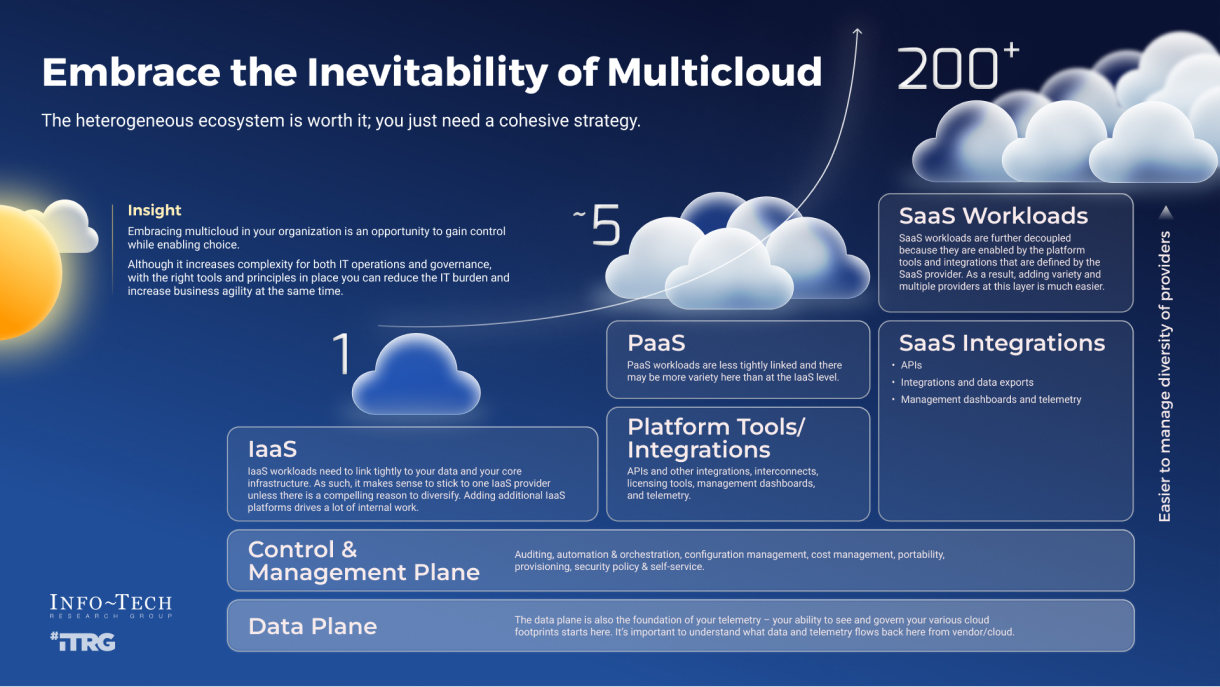
Further reading
Embrace the Inevitability of Multicloud
The heterogeneous ecosystem is worth it; you just need a cohesive strategy.
Executive summary
|
Your Challenge |
Common Obstacles |
Info-Tech’s Approach |
|---|---|---|
|
It used to be easy: pick your cloud, build out your IT footprint, and get back to business. But the explosion of cloud adoption has also led to an explosion of options for cloud providers, platforms, and deployment. And that’s just when talking about infrastructure as a service! For many businesses, one of the key benefits of the cloud ecosystem is enabling choice for different users, groups, and projects in the organization. But this means embracing multiple cloud platforms. Is it worth it? |
The reality is that multicloud is inevitable for most organizations, and if it’s not yet a reality for your IT team, it soon will be. This brings new challenges:
|
By defining your end goals, framing solutions based on the type of visibility and features your multicloud footprint needs to deliver, you can enable choice and improve performance, flexibility, and availability.
|
Info-Tech Insight
Embracing multicloud in your organization is an opportunity to gain control while enabling choice. Although it increases complexity for both IT operations and governance, with the right tools and principles in place you can reduce the IT burden and increase business agility at the same time.
Project overview
|
Multicloud isn’t good or bad; it’s inevitable |
The reality is multicloud is usually not a choice. For most organizations, the requirement to integrate with partners, subsidiaries, and parent organizations, as well as the need to access key applications in the software-as-a-service ecosystem, means that going multicloud is a matter of when, not if. The real question most businesses should ask is not whether to go multicloud, but rather how to land in multicloud with intent and use it to their best advantage. |
|---|---|
|
Your workloads will guide the way |
One piece of good news is that multicloud doesn’t change the basic principles of a good cloud strategy. In fact, a well-laid-out multicloud approach can make it even easier to put the right workloads in the right place – and then even move them around as needed. This flexibility isn’t entirely free, though. It’s important to know how and when to apply this type of portability and balance its benefits against the cost and complexity that come with it. |
|
Don’t fall in reactively; land on your feet |
Despite the risks that come with the increased scale and complexity of multicloud, it is possible to maintain control, realize the benefits, and even use multicloud as a springboard for leveraging cloud benefits in your business. By adopting best practices and forethought in key areas of multicloud risk, you can hit the ground running. |
Aligning the terms
Modern organizations have multiple IT footprints. How do we classify different stances?
01 Hybrid Cloud
Private cloud and public cloud infrastructure managed as one entity
02 Multicloud
Includes multiple distinct public cloud services, or “footprints”
03 Hybrid IT
Putting the right workloads in the right places with an overall management framework
Info-Tech Insight
- Hybrid cloud is about applying the same service model across multiple deployment models (most commonly public and private clouds).
- Multicloud is about using multiple cloud offerings irrespective of differences in service model or deployment model.
Multicloud
- An approach that includes multiple distinct public cloud services (e.g. AWS EC2 but also Salesforce and M365)
- Usually defined around a steady state for each workload and footprint
- Everything in its right place (with portability for events and disasters)
- NOT everything everywhere all at once

Multicloud is inevitable
The SaaS ecosystem has led organizations to encourage business units to exercise the IT choices that are best for them.
The multicloud maturity journey
- Move a workload to the cloud
- Move more workloads to the same cloud
- Move the right workloads to the right clouds
- Hybrid cloud & multicloud
- Integrate cloud and traditional/ on-premises footprints
Hybrid IT: Aggregate Management, Monitoring, Optimization, Continuous Improvement
Multicloud is about enabling choice while maintaining oversight
The broader your footprint, the harder it becomes to manage risks across each environment.
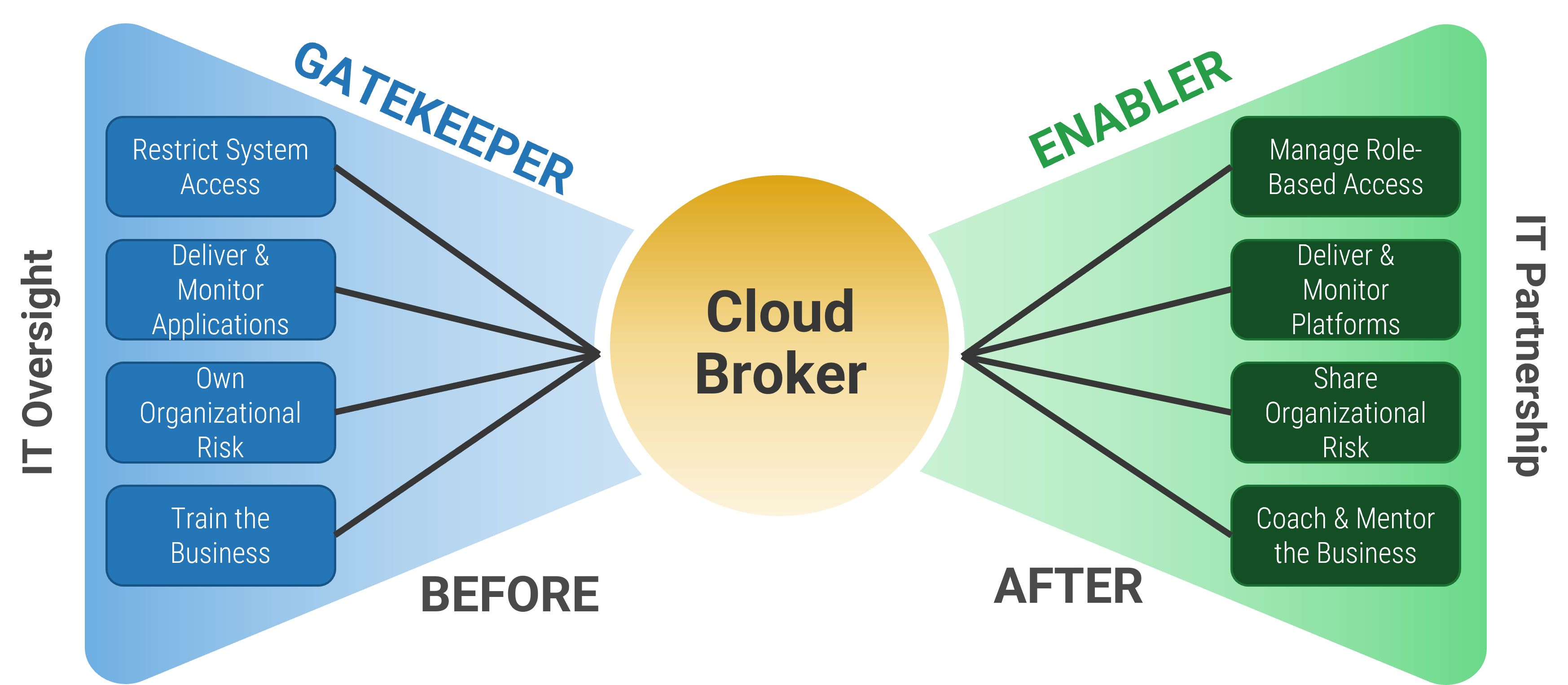
Managing multicloud risks
The risks in multicloud are the same as in traditional cloud but amplified by the differences across footprints and providers in your ecosystem.
- Variations across platforms include:
- Rules
- Security
- Mapping corresponding products and services
- Training and certifications by platform/provider
- Managing cost across footprints
- Complexity of integration
- Managing compliance across platforms
- Loss of standardization due to multicloud fragmentation
Info-Tech Insight
Don’t be afraid to ask for help! Each cloud platform you adopt in your multicloud posture requires training, knowledge, and execution. If you’re already leveraging an ecosystem of cloud providers, leverage the ecosystem of cloud enablers as needed to help you on your way.
Despite the risks, multicloud is a springboard
|
Increasing flexibility & accelerating integration |
Because multicloud increases the number of platforms and environments available to us, we can Multicloud also can be a catalyst for integrating and stitching together resources and services that were previously isolated from each other. Because of the modular design and API architecture prevalent in cloud services, they can be easily consumed and integrated from your various footprints. |
|---|---|
|
Modernizing data strategy |
While it may seem counterintuitive, a proactive multicloud approach will allow you to regain visibility and control of your entire data ecosystem. Defining your data architecture and policies with an eye to the inevitability of multicloud means you can go beyond just regaining control of data stranded in SaaS and other platforms; you can start to really understand the flows of data and how they affect your business processes for better or worse. |
|
Move to cloud-native IT & design |
Embracing multicloud is also a great opportunity to embrace the refactoring and digital transformation you’ve been blocked on. Instead of treading water with respect to keeping control of fragmented applications, services, and workloads, a proactive approach to multicloud allows you to embrace open standards built to deliver cloud-native power and portability and to build automations that increase reliability, performance, and cost effectiveness while reducing your total in-house work burden. |
Info-Tech Insight
Don’t bite off more than you can chew! Especially with IaaS and PaaS services, it’s important to ensure you have the skills and bandwidth to manage and deploy services effectively. It’s better to start with one IaaS platform, master it, and then expand.
Let your workloads guide the way
Multicloud is a road to best-of-breed everything

Stick with a workload-level approach
| The principles of cloud strategy don’t change with multicloud! | 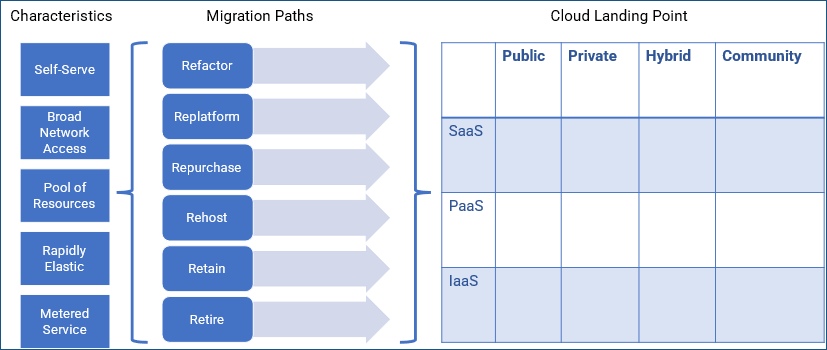
|
| If anything, a multicloud approach increases your ability to put the right workloads in the right places, wherever that may be. | |
| It can also (with some work and tooling) provide even broader options for portability and resilience. |
Multicloud = multiple right places
Put everything in its right place.
Just like with any cloud strategy, start with a workload-level approach and figure out the right migration path and landing point for your workload in cloud.
Understand the other right places!
Multicloud means for many workloads, especially IaaS- and PaaS-focused ones, you will have multiple footprints you can use for secondary locations as desired for portability, resilience, and high availability (with the right tooling and design).
Info-Tech Insight
Portability is always a matter of balancing increased flexibility, availability, and resilience against increased complexity, maintenance effort, and cost. Make sure to understand the requirement for your workloads and apply portability efforts where they make the most sense
Your management will need to evolve
Don’t manage multicloud with off-the-rack tools.
The default dashboards and management tools from most cloud vendors are a great starting point when managing a single cloud. Unfortunately, most of these tools do not extend well to other platforms, which can lead to multiple dashboards for multiple footprints.
These ultimately lead to an inability to view your multicloud portfolio in aggregate and fragmentation of metrics and management practices across your various platforms. In such a situation maintaining compliance and control of IT can become difficult, if not impossible!
Unified standards and tools that work across your entire cloud portfolio will help keep you on track, and the best way to realize these is by applying repeatable, open standards across your various environments and usually adopting new software and tools from the ecosystem of multicloud management software platforms available in the market.
Info-Tech Insight
Even in multicloud, don’t forget that the raw data available from the vendor’s default dashboards is a critical source of information for optimizing performance, efficiency, and costs.
Multicloud management tool selection
The ecosystem is heterogeneous.
The explosion of cloud platforms and stacks means no single multicloud management tool can provide support for every stack in the private and public cloud ecosystem. This challenge becomes even greater when moving from IaaS/PaaS to addressing the near-infinite number of offerings available in the SaaS market.
When it comes to selecting the right multicloud management tool, it’s important to keep a few things in mind:
- Mapping your requirements to the feature sets for your multicloud management platform is critical.
- Depending on your goals and metrics, and the underlying platforms and data you need to collect from them, you may need more than one tool.
- Especially when it comes to integrating SaaS into your multicloud tool(s), development or partners may be required.
Key Features
- Portability
- Cost management
- Automation across vendors
- Standardization of configuration
- Security alignment across vendors
- Unified provisioning and self-service
Info-Tech Insight
SaaS always presents a unique challenge for gathering necessary cloud management data. It’s important to understand what data is and isn’t available and how it can be accessed and made available to your multicloud management tools.
Understand your vendors
Define what you are looking for as a first step.
- To best understand your options, you need to understand the focus, features, and support services for each vendor. Depending on your requirements, you may need to adopt more than one tool.
- Remember that SaaS presents unique challenges in terms of accessing and ingesting data into your management tools. This will generally require development to leverage the provider’s API.
- Within the following slides, you will find a defined activity with a working template that will create a vendor profile for each vendor.
As a working example, you can review these vendors on the following slides:
- VMware CloudHealth
- ServiceNow ITOM
- CloudCheckr
Info-Tech Insight
Creating vendor profiles will help quickly identify the management tools that meet your multicloud needs.
Vendor Profile #1
VMware CloudHealth
Vendor Summary
CloudHealth is a VMware management suite that provides visibility into VMware-based as well as public cloud platforms. CloudHealth focuses on providing visibility to costs and governance as well as applying automation and standardization of configuration and performance across cloud platforms.
Supported Platforms
Supports AWS, Azure, GCP, OCI, VMware
Feature Sets
- Portability
- Cost management
- Automation across platforms
- Standardization of configuration
- Security alignment across platforms
- Unified provisioning and self-service
Vendor Profile #2
ServiceNow ITOM
Vendor Summary
ServiceNow IT Operations Management (ITOM) is a module for the ServiceNow platform that allows deep visibility and automated intervention/remediation for resources across multiple public and private cloud platforms. In addition to providing a platform for managing workload portability and costs across multiple cloud platforms, ServiceNow ITOM offers features focused on delivering “proactive digital operations with AIOps.”
URL: servicenow.com/products/it-operations-management.html
Supported Platforms
Supports CloudFormation, ARM, GDM, and Terraform templates. Also provisions virtualized VMware environments.
Feature Sets
- Portability
- Cost management
- Automation across platforms
- Standardization of configuration
- Security alignment across platforms
- Unified provisioning and self-service
Vendor Profile #3
CloudCheckr
Vendor Summary
CloudCheckr is a SaaS platform that provides end-to-end cloud management to control cost, ensure security, optimize resources, and enable services. Primarily focused on enabling management of public cloud services, CloudCheckr’s broad platform support and APIs can be used to deliver unified visibility across many multicloud postures.
URL: cloudcheckr.com
Supported Platforms
Supports AWS, Azure, GCP, SAP Hana
Feature Sets
- Portability
- Cost management
- Automation across platforms
- Standardization of configuration
- Security alignment across platforms
- Unified provisioning and self-service
Activity
Understand your vendor options
This activity involves the following participants:
- IT strategic direction decision makers
- Cloud governance team
- Cloud deployment team
- Vendor and portfolio management
Outcomes of this step:
- Vendor profile template (ppt)
Info-Tech Insight
This checkpoint process creates transparency around agreement costs with the business and gives the business an opportunity to reevaluate its requirements for a potentially leaner agreement.
Create your vendor profiles
Define what you are looking for and score vendors accordingly.
- Create a vendor profile for every vendor of interest.
- Leverage our starting list and template to track and record the advantages of each vendor.
- Morpheus (morpheusdata.com)
- OpenStack (openstack.org)
- Cloudify (cloudify.co)
- Cloudamize (cloudamize.com)
- Flexera (flexera.com)
- Virtana (virtana.com)
- IBM Multicloud Manager (ibm.com)
Vendor Profile Template
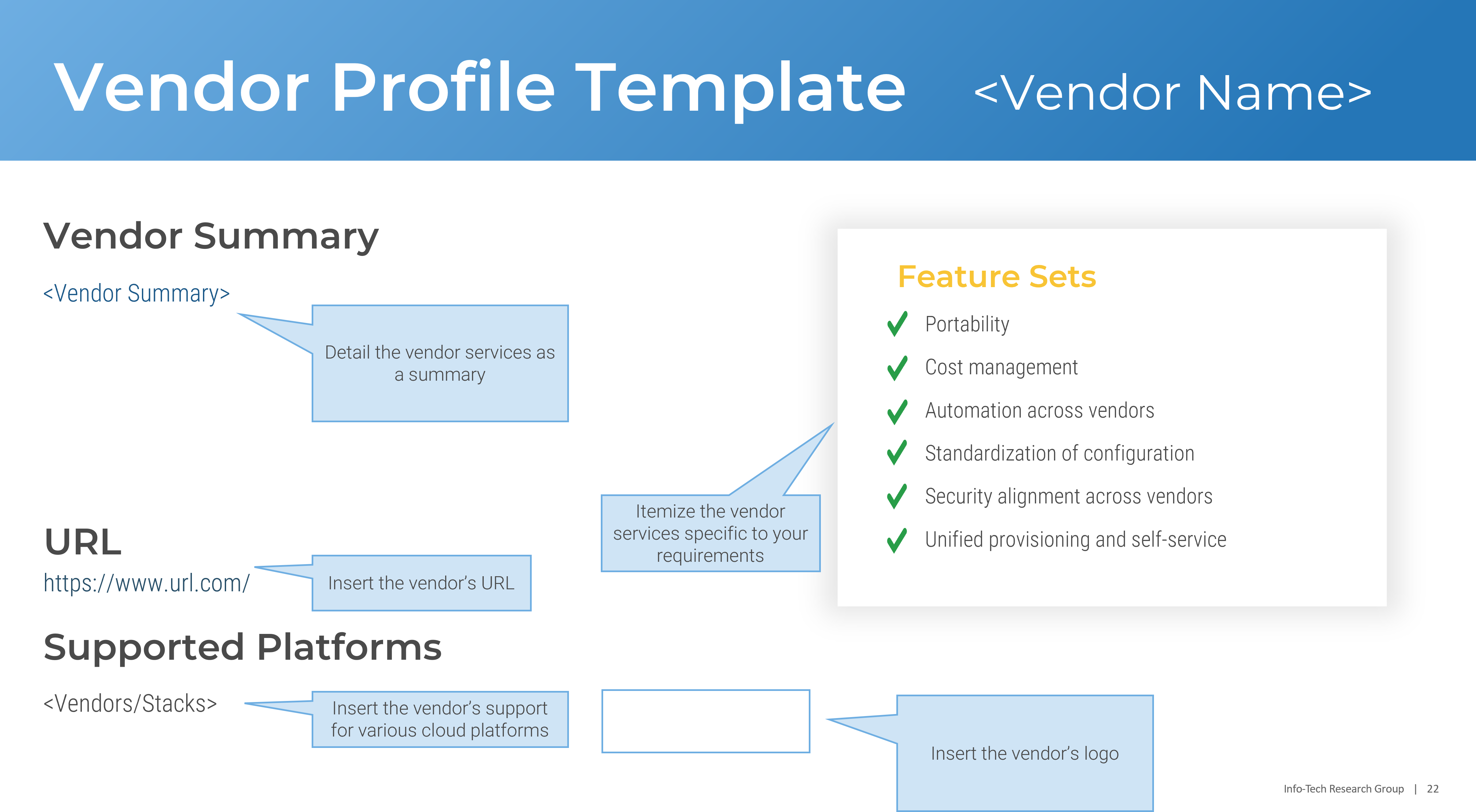
Land on your feet
Best practices to hit the ground running in multicloud
Focus your multicloud posture on SaaS (to start)
|
SaaS While every service model and deployment model has its place in multicloud, depending on the requirements of the workload and the business, most organizations end up in multicloud because of the wide ecosystem of options available at the SaaS level. Enabling the ability to adopt SaaS offerings into your multicloud footprint should be an area of focus for most IT organizations, as it’s the easiest way to deliver business impact (without taking on additional infrastructure work). |
IaaS and PaaS Although IaaS and PaaS also have their place in multicloud, the benefits are usually focused more on increased portability and availability rather than on enabling business-led IT. Additionally, multicloud at these levels can often be complex and/or costly to implement and maintain. Make sure you understand the cost-benefit for implementing multicloud at this level! |
Where the data sits matters
With multiple SaaS workloads as well as IaaS and PaaS footprints, one of the biggest challenges to effective multicloud is understanding where any given data is, what needs access to it, and how to stitch it all together.
In short, you need a strategy to understand how to collect and consolidate data from your multiple footprints.
Relying solely on the built-in tools and dashboards provided by each provider inevitably leads to data fragmentation – disparate data sets that make it difficult to gain clear, unified visibility into your cloud’s data.
To address the challenge of fragmented data, many organizations will require a multicloud-capable management platform that can provide access and visibility to data from all sources in a unified way.
Weigh portability against nativeness
When it comes to multicloud, cloud-native design is both your enemy and your friend. On one hand, it provides the ability to fully leverage the power and flexibility of your chosen platform to run your workload in the most on-demand, performance-efficient, utility-optimized way possible.
But it’s important to remember that building cloud-native for one platform directly conflicts with that workload’s portability to other platforms! You need to understand the balance between portability and native effectiveness that works best for each of your workloads.
Info-Tech Insight
You can (sort of) have the best of both worlds! While the decision to focus on the cloud-native products, services, and functions from a given cloud platform must be weighed carefully, it’s still a good idea to leverage open standards and architectures for your workloads, as those won’t hamper your portability in the same way.
Broaden your cost management approach
Even on singular platforms, cloud cost management is no easy task. In multicloud, this is amplified by the increased scale and scope of providers, products, rates, and units of measure.
There is no easy solution to this – ultimately the same accountabilities and tasks that apply to good cost management on one cloud also apply to multicloud, just at greater scale and impact.
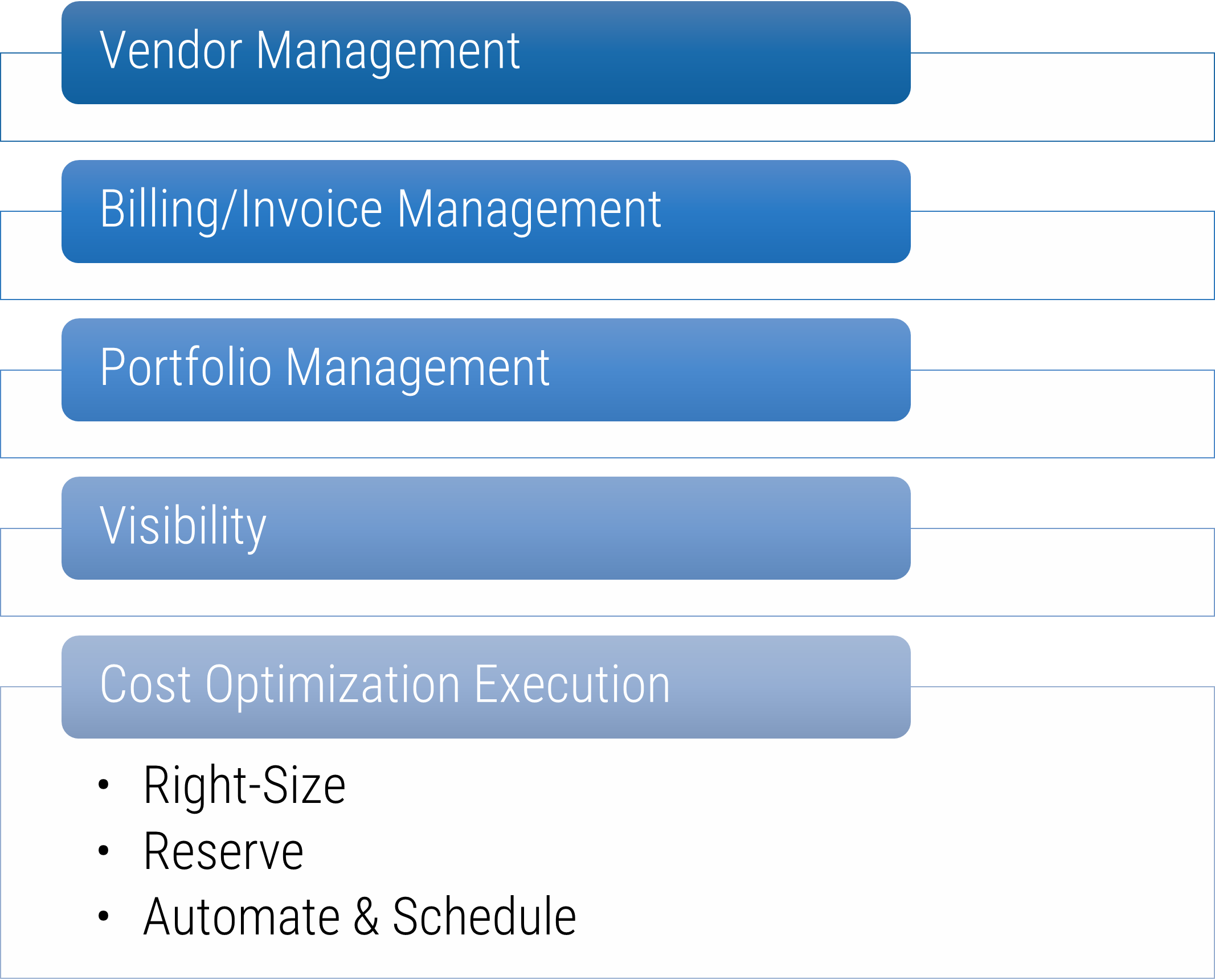
Info-Tech Insight
Evolving your tooling applies to cost management too. While the vendor-provided tools and dashboards for cost control on any given cloud provider’s platform are a good start and a critical source for data, to get a proper holistic view you will usually require multicloud cost management software (and possibly some development work).
Think about the sky between the clouds
A key theme in cloud service pricing is “it’s free to come in, but it costs to leave.” This is a critical consideration when designing the inflows and outflows of data, interactions, transactions, and resources among workloads sitting on different platforms and different regions or footprints.
When defining your multicloud posture, think about what needs to flow between your various clouds and make sure to understand how these flows will affect costs, performance, and throughput of your workloads and the business processes they support.
- Integration and Interfaces
- Business Process and Application Flows
- Inter-cloud Transit Costs
Mature your management technology
|
Automation Is Your Friend Managing multicloud is a lot of work. It makes sense to eliminate the most burdensome and error-prone tasks. Automating these tasks also increases the ease and speed of workload portability in most cases. Automation and scheduling are also key enablers of standardization – which is critical to managing costs and other risks in multicloud. Create policies that manage and optimize costs, resource utilization, and asset configuration. Use these to reduce the management burden and risk profile. |
Evolve Your Tooling Effective multicloud management requires a clear picture of your entire cloud ecosystem across all footprints. This generally isn’t possible using the default tools for any given cloud vendor. Fortunately, there is a wide ecosystem of multicloud tools to help provide you with a unified view. The best cloud management tools will not only allow you to get a unified view of your IT operations regardless of where the resources lie but also help you to evaluate your multiple cloud environments in a unified way, providing a level playing field to compare and identify opportunities for improvement. |
Info-Tech Insight
Embrace openness! Leveraging open standards and technologies doesn’t just ease portability in multicloud; it also helps rationalize telemetry and metrics across platforms, making it easier to achieve a unified management view.
Multicloud security
Multicloud security challenges remain focused around managing user and role complexity
- Fragmentation of identity and access management
- Controlling access across platforms
- Increased complexity of roles
- API security
- Managing different user types and subscriptions across different service models
- Managing security best practices across multiple platforms
- Potential increased attack surface
Info-Tech Insight
Don’t reinvent the wheel! Where possible, leverage your existing identity and access management platforms and role-based access control (RBAC) discipline and extend them out to your cloud footprints.
Don’t fall in reactively!
- Multicloud isn’t bad or good.
- Put everything the right place; understand the other right places.
- Know where your data goes.
- Automation is your friend.
- Strategy fundamentals don’t change.
- Focus on SaaS (to start).
- Embrace openness.
- Modernize your tools.
Related Info-Tech Research
Define Your Cloud Vision
This blueprint covers a workload-level approach to determining cloud migration paths
10 Secrets for Successful Disaster Recovery in the Cloud
This research set covers general cloud best practices for implement DR and resilience in the cloud.
Bibliography
“7 Best Practices for Multi-Cloud Management.” vmware.com, 29 April 2022. Web.
Brown, Chalmers. “Six Best Practices For Multi-Cloud Management.” Forbes, 22 Jan. 2019. Web.
Curless, Tim. “The Risks of Multi-Cloud Outweigh the Benefits.” AHEAD, n.d. Web.
Tucker, Ryan. “Multicloud Security: Challenges and Solutions.” Megaport, 29 Sept 2022. Web.
Velimirovic, Andreja. “How to Implement a Multi Cloud Strategy.” pheonixNAP, 23 June 2021. Web.
“What is a Multi-Cloud Strategy?” vmware.com, n.d. Web.
Buying Options
Embrace the Inevitability of Multicloud
IT Risk Management · IT Leadership & Strategy implementation · Operational Management · Service Delivery · Organizational Management · Process Improvements · ITIL, CORM, Agile · Cost Control · Business Process Analysis · Technology Development · Project Implementation · International Coordination · In & Outsourcing · Customer Care · Multilingual: Dutch, English, French, German, Japanese · Entrepreneur
Tymans Group is a brand by Gert Taeymans BV
Gert Taeymans bv
Europe: Koning Albertstraat 136, 2070 Burcht, Belgium — VAT No: BE0685.974.694 — phone: +32 (0) 468.142.754
USA: 4023 KENNETT PIKE, SUITE 751, GREENVILLE, DE 19807 — Phone: 1-917-473-8669
Copyright 2017-2022 Gert Taeymans BV